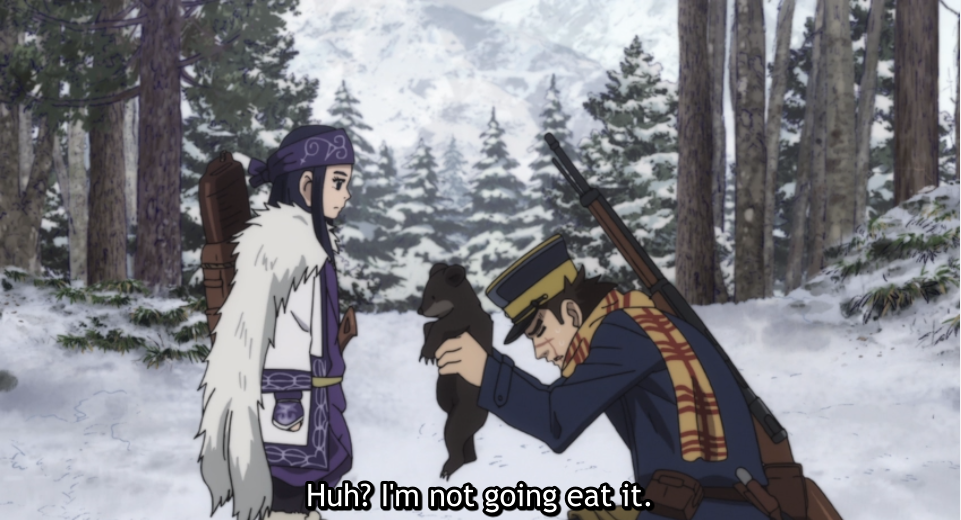Anime Review: Golden Kamuy
Japan may have won the Russo-Japanese War in 1905, but not all of the soldiers came home…not even the living ones. Sugimoto, nicknamed “Immortal Sugimoto” for his ferocity and amazing ability to survive battles and wounds, came home just long enough to learn his best friend’s widow was going blind. He went to Hokkaido to pan gold in hopes of getting enough money for the operation she needs. It’s not going well.

One night, a drunken drifter tells Sugimoto a wild story about a lost pile of gold supposedly gathered by the Ainu to fund an uprising until they were betrayed by one of their own. The man hid the gold somewhere before he was captured and sent to the notorious Abashiri Prison. While there, he tattooed twenty-four prisoners with pieces of a map, then created a way for them to escape. The tattooed criminals scattered, but if someone managed to get hold of all the pieces of the map, they’d find the treasure.
Sugimoto dismisses this as an obvious pipe dream, until the sobered-up drifter tries to kill him the next day for knowing too much. In the nearby woods, Sugimoto runs into an Ainu girl named Asirpa, and they team up to kill a bear that’s tasted human flesh. The flesh of the drifter, who happens to have some strange tattoos on his body, like part of a map.
Realizing that the man was telling at least part of the truth, Sugimoto reveals the story to Asirpa. As it happens, her father Wilk was one of the people the criminal who took the gold betrayed and murdered. She agrees to help Sugimoto find the gold–Sugimoto deciding that most of it should be returned to the Ainu.
But there are lots of other people after the gold. Some of them are the escaped prisoners, most of them murderous. Asirpa and Sugimoto reluctantly ally themselves with “Escape King” Shiraishi, a less-violent robber who was only in Abashiri because no lesser prison could hold him. More dangerously, the aged but still deadly samurai Hijikata has gathered a band to pursue the gold for his political ambitions.
Also with political ambitions is First Lieutenant Tsurumi of the elite 7th Division. He’s leading his men on a rogue mission to find the gold and set up their own fiefdom. Despite having suffered a brain injury that has left him unstable at best, Lt. Tsurumi is charismatic and his men are some of the best soldiers Japan had.
Other characters appear, each with their own hidden motives. Alliances are made and broken, but at least there’s food to enjoy!
This anime series is based on the award-winning shounen (boys’) manga by Satoru Noda. It’s known for abrupt tone shifts from survival adventure to humor to near-horror to cooking show.
The Ainu are the native population of Hokkaido and points north in Japan, and are ethnically and culturally distinctive from the folks we normally think of as “Japanese.” During the time period depicted, the majority Japanese were still relatively thinly populated in Hokkaido, so it was still possible for the Ainu to practice much of their traditional culture, but they were being pushed out of their lands and in some cases forcibly assimilated. For a very crude simile, think of how Native Americans were treated under Manifest Destiny.
The author’s done their research, and uses consultants to get Ainu customs and outfits right. Quite a bit of time is spent preparing and eating food. Some of the dishes, like deer brains, are disturbing to Sugimoto, though delicious, but then his dried miso seasoning looks like fecal matter to Asirpa.
One of the running themes is that war damages people, and almost all the veterans have grievances of one sort or another. Sugimoto was denied an honorable discharge because he beat up an officer who’d given stupid orders, and the 7th Division was discarded as a political liability when their commander committed suicide (or did he?) Others bear more obvious scars.
Some of the most controversial bits from the manga have been cut or trimmed down for the anime, but there’s still plenty of disturbing stuff, especially the episodes involving the taxidermist, which go full Clive Barker. Senior high viewers and up, but sensitive viewers may want to skip this show.
Two seasons are out, and the second season ends with a major change to the status quo. No one is anywhere near the gold, though.
If you can stomach the rough stuff, the cultural bits and a look at 1900s Japan is well worth the watch.

